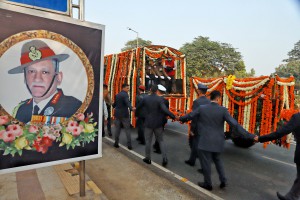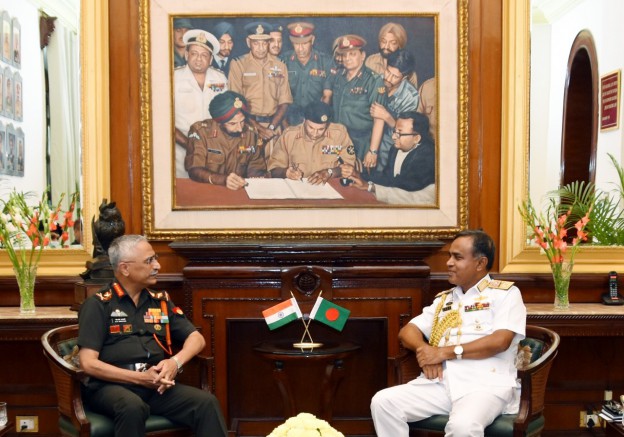Theaterisation being a key to jointness, General Rawat had put forth proposals to reorganise the current service specific commands with diverse geographic areas of responsibilities into homogeneous operational entities.
The untimely demise of General Bipin Rawat, the first Chief of Defence Staff (CDS) in a tragic MI17V5 helicopter crash on 8 December 2021 near Coonoor, Nilgiris Hills, in Tamil Nadu came as a rude shock to the whole country. The calamity could not have struck at a worst time, given the nation faces unprecedented security challenges and the process of transformational military reforms was just beginning to take shape under the helmsmanship of the CDS. While the nation lost an illustrious military leader,

New Delhi, Dec 10 (ANI): Funeral procession of late Chief of Defence Staff (CDS) Gen Bipin Rawat and his wife Madhulika Rawat from their residence to Brar Square in Delhi cantonment, where they will be cremated with full military honours, in New Delhi on Friday. General Bipin Rawat along with his wiife and 11 armed forces personnel killed in Helicopter crash in Coonoor on Wednesday. (ANI Photo/Amit Sharma)
it is incumbent that the momentum of military reforms aimed towards achieving tri-service integration and jointness is not only maintained but given further traction in view of the larger national security gamut.
Defence preparedness and modernisation of the armed forces are an ongoing phenomenon, in keeping with the threat perception and national objectives. The process is driven either by the doctrinal and technological considerations or by crisis per se; in case of India it has been more of the latter, largely in the form of incremental modernisation. Major reforms were shunned primarily due to the lack of political will and absence of a clearly defined national defence policy.
One of the glaring shortcomings in the Indian security edifice has been the absence of institutionalised structures and mechanism for the tri service jointness; seriously impinging on the “higher direction of war” and synergised application of combat power in a holistic fashion. Non-employment of combat air power during the 1962 war is a case in point. Again during the initial stages of the Kargil conflict, the aspect of inter-service jointness got amply highlighted. Consequently, the concept of CDS was recommended by the “Group of Ministers” in the year 2000. It took another two decades when Genera Rawat was finally appointed as the first CDS on 1 January 2020 for a three-years term by the Narendra Modi government. This marked the beginning of the initiation of path breaking defence reforms.
The prime role of the CDS is to promote inter service integration and jointness; major areas include doctrines, operations, planning, training, allocation of resources, procurements and restructuring towards the creation of theatre commands. Given the vast nature of the charter, the CDS dons three hats: a four star General-first among equals vis-à-vis the three service chiefs, Secretary Department of Military Affairs (DMA) and permanent Chairman of Chief of Staff Committee (COSC). Besides being adviser to the Defence Minister, the CDS acts as one point contact for the civilian leadership. Although CDS heads the COSC, the three chiefs continue to exercise operational control over their respective service. However, once the restructuring is in place, willy nilly, the CDS will exercise operational control over the theatre commands. Then the service chiefs will be primarily responsible for training and equipment of their respective services.
Given the service-specific silo system that was in place for the last seven decades, to get all the stakeholders involved in the transformational process is obviously an uphill task. Theaterisation is a strategic imperative to prosecute future multifaceted hybrid wars. Today, distinction between peace and war stands merged. The traditional concept of deterrence is supplemented by new doctrines of “pre-emption” and “prevention”. The battlefields are non-linear and fluid, characterised by network-centricity, demanding decision making in a telescopic time frame. This implies integration of all war waging resources in a theatre under a single commander to ensure optimal synergy and real time responses.
Our current military organisational structure based on 17 service-specific commands is not conducive for the conduct of “fifth generation” warfare. Further, to scale up its defence preparedness, China with over 22,000 km land borders and 14,500 km coastline has organised its 2 million strong military into five theatre commands, under the direct operational control of the Central Military Commission (CMC), headed by President Xi Jinping. The People’s Liberation Army (PLA) Western Theatre Command is responsible for the complete Sino-Indian border and has obvious operational advantage in application of its combat potential at a short notice.
Theaterisation being a key to jointness, General Rawat had put forth proposals to reorganise the current service specific commands with diverse geographic areas of responsibilities into homogeneous operational entities. Just to illustrate, at present the Headquarters of Western Commands of the three services are at different locations—Army at Chandimandir, Air Force at Delhi and Navy at Mumbai. The restructuring aims at the creation of integrated theatre commands; two land-based commands, Western and Eastern, responsible for Pakistan and the China borders, respectively; one Maritime Command and one Air Defence Command. The envisaged integrated logistics command is to cater to the combined requirements of the three services. For the time being, status quo is to be maintained with the Army’s Northern Command because of operational constraints. Currently, there are two tri service commands already in place, namely, Far Eastern Naval Command and Strategic Forces Command (SFC).
The CDS had set April 2022 as timeline to have the integrated theatre command structures in place. This required a colossal amount of groundwork and building consensus, given the serious concerns of the individual services, particularly the Air Force. Numerous studies were in progress to iron out the wrinkles as also the testing of the new organisations on the ground. It is ironic that General Rawat was not to see through the culmination of the first stage of this transformation.
The new CDS will soon be appointed by the Government to continue the process of defence reforms. General Rawat has already laid a strong foundation which will enable the next incumbent to hit the ground running. The on-going process of transformation is expected to take a couple of years before it stabilises and becomes operationally effective. The ambit of jointness and theaterisation encompasses a number of other agencies, beyond the three services. These include the integration of the paramilitary forces and assets particularly in the border areas, calling for robust military-civil fusion.
China is already engaged in pursuing a “Grey Zone” warfare along the LAC by resorting to “non-contact” tactics. It entails gradual nibbling and feverishly building a string of villages in the bordering areas with a military component inbuilt, so as to make Tibet an impregnable shield, in consonance with the Communist leadership’s grand design. Alongside, Pakistan is continuing with its proxy war, employing the toolkit of “cross border terrorism”. Thus the two-front war is already a reality. Hence it is time for India to undertake an exhaustive strategic review and formulate a pragmatic defence policy in a long term perspective. General Rawat has rendered yeoman service towards this end by setting into gear the much awaited defence transformation process, while he passes into history.
Maj Gen (Dr) G.G. Dwivedi (Retd) is a War Veteran, former Assistant Chief Integrated Defence Staff; currently Professor Strategic and International Relations.


